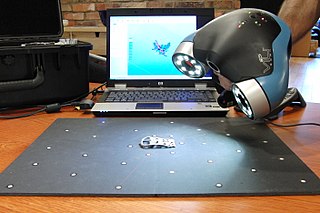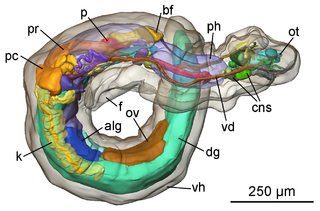Related Research Articles
Computational archaeology describes computer-based analytical methods for the study of long-term human behaviour and behavioural evolution. As with other sub-disciplines that have prefixed 'computational' to their name, the term is reserved for methods that could not realistically be performed without the aid of a computer.

Photogrammetry is the science and technology of obtaining reliable information about physical objects and the environment through the process of recording, measuring and interpreting photographic images and patterns of electromagnetic radiant imagery and other phenomena.

Visualization or visualisation is any technique for creating images, diagrams, or animations to communicate a message. Visualization through visual imagery has been an effective way to communicate both abstract and concrete ideas since the dawn of humanity. Examples from history include cave paintings, Egyptian hieroglyphs, Greek geometry, and Leonardo da Vinci's revolutionary methods of technical drawing for engineering and scientific purposes.

A virtual museum is a digital entity that draws on the characteristics of a museum, in order to complement, enhance, or augment the museum experience through personalization, interactivity and richness of content. Virtual museums can perform as the digital footprint of a physical museum, or can act independently, while maintaining the authoritative status as bestowed by the International Council of Museums (ICOM) in its definition of a museum. In tandem with the ICOM mission of a physical museum, the virtual museum is also committed to public access; to both the knowledge systems imbedded in the collections and the systematic, and coherent organization of their display, as well as to their long-term preservation.

3D scanning is the process of analyzing a real-world object or environment to collect data on its shape and possibly its appearance. The collected data can then be used to construct digital 3D models.
Software visualization or software visualisation refers to the visualization of information of and related to software systems—either the architecture of its source code or metrics of their runtime behavior—and their development process by means of static, interactive or animated 2-D or 3-D visual representations of their structure, execution, behavior, and evolution.
Informative modelling is an interdisciplinary methodological approach linking information technologies with architectural analysis and modelling (at various scales, from architectural elements to buildings and structures). Informative modelling aims at improving the way information and evidences about how architectural objects evolved through time can be visually displayed.
Virtual heritage or cultural heritage and technology is the body of works dealing with information and communication technologies (ICT) and their application to cultural heritage, such as virtual archaeology. It aims to restore ancient cultures as real (virtual) environments where users can immerse.

Internet Archaeology is an academic journal and one of the first fully peer-reviewed electronic journals covering archaeology. It was established in 1996. The journal was part of the eLIb project's electronic journals. The journal is produced and hosted at the Department of Archaeology at the University of York and published by the Council for British Archaeology. The journal has won several awards for its creative exemplars of linked e-publications and archives.
NESPOS is an open source information platform about Pleistocene humans, providing detailed information about important sites, their analytical results, archaeological findings and a selection of literary quotes. Moreover, it is a repository where archaeologists and paleoanthropologists can exchange their research results and ideas by a protected Wiki-based collaboration platform with a continuously growing sample of 3D scanned human fossils and artefacts.
Paul Reilly is a pioneer of virtual archaeology and data visualisation in archeology. He was a research scientist at the IBM UK Scientific Centre. He received his B.A. Honours degree in archaeology and history from the University of Leeds and his Ph.D in computer-based archaeological research, at the Research Centre for Computer Archaeology in North Staffordshire Polytechnic. He has worked on many archaeological excavation and field survey projects in Britain and elsewhere in Europe. From 1986 to 1989 he was an IBM UK Scientific Centre Research Fellow and became Research Scientist in 1989. He is currently a Visiting Research Fellow at the Archaeological Computing Research Group, University of Southampton. He has written many papers and a book, as well as editing several conference proceedings, books and journals relating to computer applications and art practice in archaeological research.

In computer vision and computer graphics, 3D reconstruction is the process of capturing the shape and appearance of real objects. This process can be accomplished either by active or passive methods. If the model is allowed to change its shape in time, this is referred to as non-rigid or spatio-temporal reconstruction.
The National Centre for Research and Restoration in French Museums is the national research centre in France responsible for the documentation, conservation and restoration of the items held in the collections of more than 1,200 museums across France. C2RMF also carries out extensive scientific studies and data recording for these collections, and is active both nationally and internationally in the field of cultural heritage conservation and analysis. The C2RMF is involved in the development of technologies and scientific procedures employed in the preservation of art works and artefacts, both on its own and in partnership with other museums and research institutions across the globe.
Polynomial texture mapping (PTM), also known as Reflectance Transformation Imaging (RTI), is a technique of imaging and interactively displaying objects under varying lighting conditions to reveal surface phenomena. The data acquisition method is Single Camera Multi Light (SCML).

Boštjan Burger is a Slovenian informatician, geographer, a panoramic and VR panoramic photographer and a speleologist. He was founder of the Burger Landmarks website and had retired as computer programmer in the 1990s to become a geographic researcher on the hydrology of waterfalls. He used VR panoramas as a tool in the research of landscapes. He was greatly influenced by geographer Don Bain for documenting the landscape with VR panoramas and Hans Nyberg for his use of QuickTime VR fullscreen panoramas.

Sarah Kenderdine is a professor of Digital Museology at the École polytechnique fédérale de Lausanne (EPFL), Switzerland, since 2017. She leads the laboratory for experimental museology (eM+), exploring the convergence of aesthetic practice, visual analytics and cultural data. Kenderdine develops interactive and immersive experiences for museums and galleries, often employing interactive cinema and augmented reality.
Visual computing is a generic term for all computer science disciplines dealing with images and 3D models, such as computer graphics, image processing, visualization, computer vision, virtual and augmented reality and video processing. Visual computing also includes aspects of pattern recognition, human computer interaction, machine learning and digital libraries. The core challenges are the acquisition, processing, analysis and rendering of visual information. Application areas include industrial quality control, medical image processing and visualization, surveying, robotics, multimedia systems, virtual heritage, special effects in movies and television, and computer games.
Digital archaeology is the application of information technology and digital media to archaeology. It includes the use of digital photography, 3D reconstruction, virtual reality, and geographical information systems, among other techniques. Computational archaeology, which covers computer-based analytical methods, can be considered a subfield of digital archaeology, as can virtual archaeology.

The GigaMesh Software Framework is a free and open-source software for display, editing and visualization of 3D-data typically acquired with structured light or structure from motion.
Computer Applications and Quantitative Methods in Archaeology (CAA) is a global organization bringing together archaeologists, mathematicians and computer scientists. Its aims are to encourage communication between these disciplines, to provide a survey of present work in the field, and to stimulate discussion and future progress. CAA International organizes the annual meetings of its members since 1970s. Nowadays, it is grown into a large community of more than 1000 scholars from around the world. Its members created a dozen of a National CAA chapters, and special interest groups. CAA International publishes annual proceedings and the Journal of Computer Applications in Archaeology (JCAA).
References
- ↑ 1, Reilly P., 1991. Towards a virtual archaeology. CAA’90. BAR Intern.s. Vol.565:133–139.
- ↑ 2, САА https://caaconference.org/ocs/index.php?conference=caa&schedConf=caa2015
- ↑ 3, London Charter for the computer-based visualisation of cultural heritage. Draft 2.1. Accessed 15 Jan 2014
- ↑ Unger, Jiří (2020). "VirtualArch: Making Archaeological Heritage Visible". Internet Archaeology (54). doi: 10.11141/ia.54.2 .
- ↑ 4, Sideris A., 2008. "Re-contextualized Antiquity: Interpretative VR Visualisation of Ancient Art and Architecture" in Mikropoulos T. A. and Papachristos N. M. (eds.), Proceedings: International Symposium on “Information and Communication Technologies in Cultural Heritage” October 16–18, 2008, University of Ioannina 2008, ISBN 978-960-98691-0-2, pp. 159-176.
- ↑ 5, Hookk D.Yu., 2014. From Illusion to reality: transformation of the term "virtual archaeology"
- ↑ 6, International project "Virtual Archaeology" http://www.virtualarchaeology.ru
- ↑ 7, Virtual archaeology (methods and benefits). Proceedings of the Second International Conference held at the State Hermitage Museum 1–3 June 2015. Ed.by D.Hookk. SPb: The State Hermitage Publishers. 290 p. ISBN 978-5-93572-608-9
- ↑ 8, Virtual archaeology (from Air, on Earth, under Water and at Museum). Proceedings of the International Forum held at the State Hermitage Museum 28–30 May 2018. Ed.by D.Hookk. SPb: The State Hermitage Publishers. 300 p. ISBN 978-5-93572-792-5
- ↑ 9,